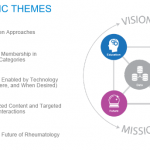Lesson 5: Diversity Matters
As someone with an advanced degree in environmental medicine as well as experience as a patient, Dr. Horonjeff began to be asked frequently to weigh in on health initiatives. She would say yes, but began to see the routine as a bit problematic.
“I looked around, and—last time I checked—there were 54 million Americans with arthritis,” she said. “So the perspective of somebody who’s white, holds a PhD and lives in New York City is not representative of the 54 million Americans with arthritis.”
Health professionals must take steps to connect with a broad swath of the patient population. She suggested starting with small steps toward engagement, learning from those steps and moving on from there.
Lesson 6: Equitably Value Patients
Patients who participate in committees for health initiatives and research projects should be compensated for their work. Participation in research projects is not a career demand for patients, unlike health professionals. So compensating a patient working in a retail job who has childcare needs, for example, to participate in research discussions is fair and necessary to obtain diverse input, Dr. Horonjeff said.
Lesson 7: Don’t Make Crap
She said scientists should be sure they’re innovating the right things. For example, telemedicine has been fine-tuned during the pandemic, she said, but it doesn’t meet the needs of some patients, who may not have a calm or private environment in which to participate in a virtual doctor visit from their house.
And the idea of digital therapeutics, such as apps, may sound great, except many patients don’t know what digital therapeutics are, she said.
Lesson 8: Prescribe Peer Support
Through advocacy organizations and participating in conferences, a doctor “can help open people’s eyes to the opportunity to connect with patients,” she said.
“That’s what truly changed my life—when I finally took these cruddy situations I was living through and flipped them on their head and used them to effect change and support other people.”
Lesson 9: You Have the Power to Empower
Health professionals have a chance to understand what a patient’s goals are and work to get them there, even during a 10-minute patient visit. Health professionals should talk to their peers for ideas on how to do this, she suggested. For her, the suggestion of participating in a juvenile arthritis conference made all the difference.
“It was my care team, it was my rheumatologist, who first got me involved,” she said. “I was able to connect with others, and I didn’t feel so ashamed of my disease.”

